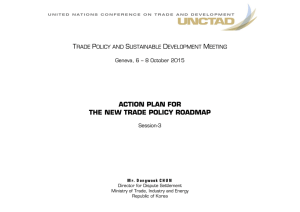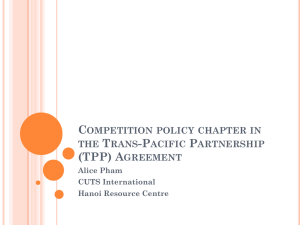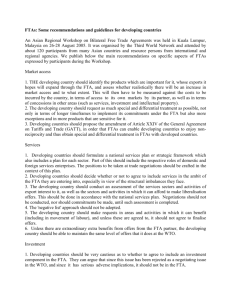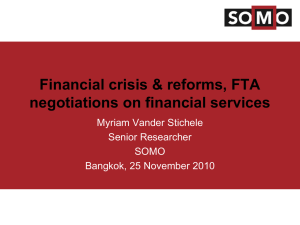URATA Shujiro The New Landscape of World Trade with Mega-FTAs
advertisement
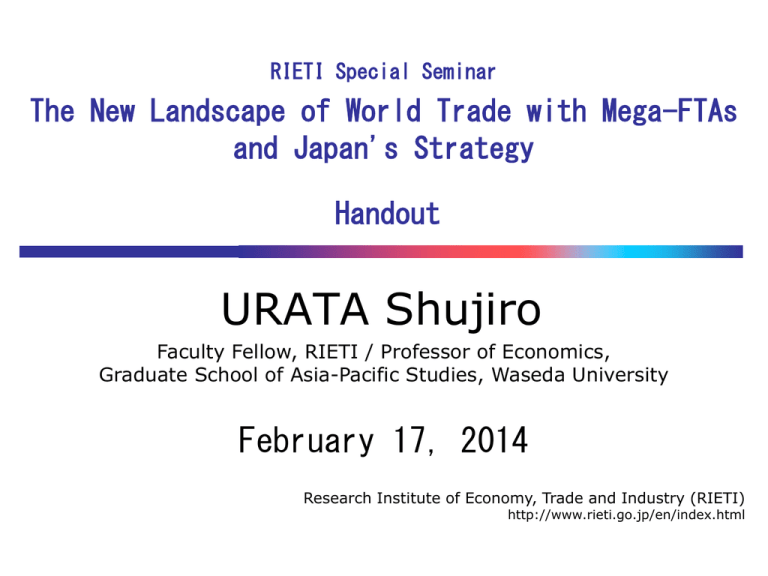
RIETI Special Seminar The New Landscape of World Trade with Mega-FTAs and Japan's Strategy Handout URATA Shujiro Faculty Fellow, RIETI / Professor of Economics, Graduate School of Asia-Pacific Studies, Waseda University February 17, 2014 Research Institute of Economy, Trade and Industry (RIETI) http://www.rieti.go.jp/en/index.html Mega-FTA Negotiations and Japan’s FTA Strategy February 17, 2014 Shujiro URATA Waseda University 1 Contents I. Japan’s Economic Situation II. Mega-FTA Negotiations III. Japan’s FTA Strategy IV. Concluding Remarks 2 1. Japan’s Economic Situation Current situation • Low economic growth • Deflation • Shortage of demand • Sign of recovery (Favorable impacts of Abenomics) Structural Problems • Declining and aging population • Declining savings rate • Increasing government debt • Regulated sectors (agriculture, medical services, etc) • Closed economy 3 GDP Growth Rates of Japan, China and the World (%) 4 GDP of Japan, China, and the US ($ billion) 5 Japan’s Declining Population 1,000 140,000 65120,000 15-64 0-14 100,000 80,000 60,000 40,000 20,000 0 6 Gross Savings-GDP Ratio (%) 7 Government Debt-GDP Ratios (%) % Japan 250 US UK Germany 200 France Italy Canada 150 100 50 0 1995 1996 1997 1998 1999 2000 2001 2002 2003 2004 2005 2006 2007 2008 2009 2010 2011 8 Trade-GDP Ratios of Selected APEC Economies (%): 2012 9 FDI Stock-GDP Ratios of Selected APEC Economies (%): 2012 10 Challenge for achieving economic growth • Increase productivity • Increase economic interaction with growing Asia-Pacific countries and the EU Solutions • Implement structural (policy) reforms • Participate in mega-FTAs 11 2. Mega FTAs Negotiations TPP Starting year 2010 Target year for conclusion 2013 # of countries 12 Leader US Model KORUS Area coverage 21 Market access high Tariff concession bilateral single Mode of agreement RCEP Japan-EU CJK TTIP 2013 2013 2013 2013 2015 16 29 3 29 ASEAN CK ASEAN+1 8 broad 15 broad medium high medium high common common common undertaking Developing countries No SDT SDT 12 Region-wide FTAs in East Asia: RCEPP, TPP, China-Japan-Korea (CJK) FTA TPP RCEP(ASEAN+6) (ASEAN+CH, JP, KR, IND, AUS, NZ) Vietnam Canada Japan Viet Nam Malaysia Singapore USA Brunei Mexico Peru TPP Australia New Zealand ASEAN+1 FTA Korea China India FTAAP (APEC) China‐Japan‐Korea Japan Russia China Korea Japan CH. CH. Taipei HongKong Thailand Brunei Malaysia Singapore Australia & NZ Vietnam Philippines Canada US Mexico Peru Indonesia PNG Australia New Zealand Chile Chile III. Japan’s FTA Strategy Current Status of Japan’s FTAs • Enacted relatively a large number of FTAs, but • Low country coverage in terms of trade: FTA coverage ratio • Low tariff elimination: lower than 90% in terms of tariff lines, whereas for the US, higher than 95% 14 Start of Signing of Enactment Partners negotiation FTAs of FTAs In action Singapore Jan 2001 Jan 2002 Nov 2002 Mexico Nov 2002 Sep 2004 Mar 2005 Dec 2005 Jul 2006 Malaysia Jan 2004 Mar 2007 Sep 2007 Chile Feb 2006 Thailand Feb 2004 Apr 2007 Nov 2007 Indonesia Jul 2005 Aug 2007 Jul 2008 Jun 2007 Jul 2008 Brunei Jun 2006 ASEAN Apr 2005 Apr 2008 Dec 2008 Philippines Feb 2004 Sep 2006 Dec 2008 Swizterland May 2007 Feb 2009 Sep 2009 Vietnam Jan 2007 Dec 2008 Oct 2009 India Jan 2007 Feb 2011 Aug 2011 Peru May 2009 May 2011 Mar 2012 Under Korea* Dec 2003 negotiation GCC Sep 2006 Australia Apr 2007 Mongolia Jun 2012 Canada Nov 2012 Colombia Dec 2012 CJK Mar 2013 EU Apr 2013 RCEP May 2013 TPP Jul 2013 Notes: *FTA negotiations with Korea have been suspended. For the TPP, the date of Japan's entry to negotiations Source: Ministry of Foreign Affairs 15 FTA Coverage Ratios: Proportion of trade with FTA partners in total trade (%), FTA (July, 2012), Trade data (2011) Source: JETRO 16 FTA Trade Liberalization Ratio (%) Japan‐Philippines FTA Japan 88.4 Japan‐Malaysia FTA Japan 86.8 Japan‐Indonesia FTA Japan 86.6 Japan‐Chile FTA Japan 86.5 Japan‐Switzerland FTA Japan 85.6 Australia‐US FTA Australia US US‐Peru FTA Peru US Korea‐US FTA US Korea 100 99 99 98 99 98 17 Japan’s Import Items Excluded from Tariff Elimination Products that have never been subject to tariff elimination (929 tariff lines, 10.3%) Five key items (586 tariff lines, 6.5%) Rice (58) Wheat (109) Sugar (131) Dairy products (188) Beef (51) and pork (49) Fishery (91) Other items Agricultural, (343 tariff forestry and Beans (16) lines, 3.8%) fishery products Konyaku (3) Prepared food (30) (248) Plywood (34) Manufactured products (95) Products that have been subject to tariff elimination (8089 tariff lines, 89.7%) Total number of Japanese imports (9018 tariff lines) Source: Masahiro Kawai 18 Motives behind FTAs • Expand export market for Japanese firms • Improve investment environment for Japanese firms • Obtain energy and natural resources • Promote structural reform in Japan • Improve and establish good relationship • Provide economic assistance to developing countries • Important component of Abenomics 19 Abenomics Three Arrows Strategy • 1) Aggressive monetary policy: radical quantity easing, inflation targeting • 2) Flexible fiscal spending: large scale public works • 3) Growth strategy (Japan Revitalization Strategy, June 14, 2013): (1) industry revitalization plan, (2) strategic market creation plan, (3) strategy of global outreach (FTAs, TPP, RCEP, Japan-EU) 20 Impacts of TPP on Japanese Economy (GDP) • Japan’s Cabinet Office: 0.66% (TPP 12 countries) • Petri, Plummer and Zhai (2012): 2.0% (TPP 12 members) 1.8% (RCEP) 4.3% (FTAAP) The Trans-Pacific Partnership and Asia-Pacific Integration: A Quantitative Assessment, Petersons Institute of International Economics 21 Economic Obstacles to FTAs (TPP, Japan-EU FTA) *Opposition from the agriculture sector • Decline in already low self-sufficiency in food supply • Negative impacts on environment • Negative impacts on regional economy *Opposition from the service sectors including medical service sector and insurance service sector *Non-tariff barriers Negative impacts on vested interest groups 22 High Tariff Agricultural Products (%) Beef Dairy products Wheat Barley Sugar Pork Corn Starch Peanuts Rice Konnyaku potato 0 200 400 600 800 1000 1200 1400 1600 1800 23 IV. Concluding Remarks • Faced with many difficult challenges, Japan has to open up its economy and carry out structural reforms, in order to achieve economic growth or to maintain high living standard, to contribute to economic growth in Asia-Pacific and in the world. • WTO liberalization being stalled, free trade agreements (FTAs) are second-best solution for promotion of trade and FDI • Japan can gain a lot from FTAs not only in East Asia but also with countries in other parts of the world such as the US, the EU, and Latin American countries • Japan should play active roles in establishing mega-FTAs: TPP, RCEP, CJK FTA, Japan-EU FTA by liberalizing its market 24 • Among them, TPP is most important, because it is high standard and comprehensive and because it puts pressure on other mega-FTAs • FTAs (particularly TPP) face opposition from the agriculture sector • Various measures including gradual phase-in liberalization, and temporary assistance (safety net) to negatively affected workers can moderate the negative impacts during the process of transition • Need strong political leadership to promote FTAs, particularly TPP • Japanese and the US leaders have to compromise to conclude TPP negotiations by realizing its importance 25
